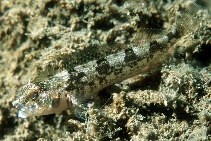| Family: |
Tripterygiidae (Triplefin blennies), subfamily: Tripterygiinae |
| Max. size: |
9.4 cm SL (male/unsexed) |
| Environment: |
demersal; marine; depth range 0 - 12 m |
| Distribution: |
Southwest Pacific: throughout New Zealand, excluding Three Kings Islands. |
| Diagnosis: |
Dorsal spines (total): 23-28; Dorsal soft rays (total): 13-15; Anal spines: 1-2; Anal soft rays: 24-27; Vertebrae: 43-45. Sloping snout profile, concave or (rarely) steep. Line from tip of premaxilla continued beyond ventral margin of orbit crossing preoperculum or touching its dorsal extremity. No groove
in front of first dorsal fin, although medial sensory pore sits at base of depression; nape naked or with superficial or embedded cycloid scales. Dorsal fin formula V-0N-0-1-0-1(35). Nine procurrent rays in upper lobe, seven in lower lobe; in upper caudal lobe, one large ray between upper lobe and posterior epural, six rays opposite epurals, one ray opposite neural spine of third preural vertebra, one ray anterior to neural spine of third preural vertebra; in lower caudal lobe, six rays opposite haemal spine of second preural vertebra, one ray opposite haemal spine of third preural vertebra (Ref. 84085). |
| Biology: |
Adults are found on sheltered coastal reefs and rock and shell substrata in bays and harbors; from intertidal pools to at least 12m (Ref. 84085). They feed on small benthic organisms. Prey is stalked and swallowed whole (Ref. 26966). Eggs are hemispherical and covered with numerous sticky threads that anchor them in the algae on the nesting sites (Ref. 240). Larvae are planktonic which occur primarily in shallow, nearshore waters (Ref. 94114). |
| IUCN Red List Status: |
Least Concern (LC); Date assessed: 06 May 2010 Ref. (130435)
|
| Threat to humans: |
harmless |
Source and more info: www.fishbase.org. For personal, classroom, and other internal use only. Not for publication.
